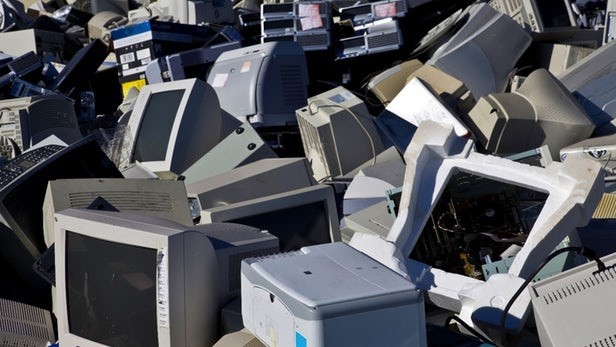Recently, the Head of the Computer Science Department at the University of Guyana, Ms. Penelope DeFreitas, conducted a survey to ascertain the perception of Guyanese when it comes to electronic disposal and management practices. This study surveyed approximately 10,000 students and staff of that institution, and concluded that much more national effort is needed in this area.
The Environmental Protection Agency (EPA) fully endorses this conclusion, and would have over the years been making strides, such as developing educational material on this topic; providing training seminars; and raising general awareness through talks with communities, groups and schools on best practices when it comes to managing these and other types of waste.
What is e-waste?
E-waste (electronic waste) is a popular, informal name for discarded computers, office electronic equipment, entertainment device electronics, mobile phones, television sets and refrigerators nearing the end of their “useful lives.” Many of these products can be reused, refurbished, or recycled, but electronic discards is one of the fastest growing areas of waste in our world today.
The United States is the world leader in producing electronic waste, tossing away about 3 million tons each year. China already produces about 2.3 million tons (2010 estimate) domestically, second only to the United States; and despite having banned e-waste imports, China remains a major e-waste dumping ground for developed countries.”
(http://en.wikipedia.org/wiki/Electronic_waste)
Is e-waste considered hazardous?
Certain components of some electronic products contain materials that cause them to be hazardous, depending on their condition and density. For instance, nonfunctioning CRTs – cathode ray tubes – which help to display images in televisions and monitors, are considered hazardous.
Environmental effects of e-waste
Computers and most electronics contain toxic materials, such as lead, zinc, nickel, flame retardants, barium, and chromium. Specifically with lead, if released into the environment, it can cause damage to human blood, kidneys, as well as central and peripheral nervous systems. When e-waste is warmed up, toxic chemicals are released into the air, damaging the atmosphere. The damage to the atmosphere is one of the biggest environmental impacts from e-waste. When electronic waste is thrown away in landfills, their toxic materials seep into groundwater, affecting both land and sea animals. This can also affect the health of the people in the developing countries where most of the electronic waste in dumped.
What should I do with my electronic discards?
The mantra of “Reduce, Reuse, Recycle” applies to electronic discards. Reduce your generation of e-waste through smart procurement and good maintenance. Reuse still functioning electronic equipment by donating or selling it to someone who can still use it; and in countries where the facilities exist, recycle those components that cannot be repaired. Some computer components can be reused in assembling new computer products, while others are reduced to metals that can be reused in applications as varied as construction, flatware, and jewelry. Eternity Investment is the only facility authorised in Guyana by the EPA to manage E-waste.
Facts about “E-Waste)
• 20 to 50 million metric tons of e-waste are disposed worldwide every year.
• Cell phones and other electronic items contain high amounts of precious metals like gold or silver. Americans dump phones containing over $60 million in gold/silver every year.
• Only 12.5% of e-waste is currently recycled.
• It takes 539 lbs. of fossil fuel, 48 lbs. of chemicals, and 1.5 tons of water to manufacture one computer and monitor.
